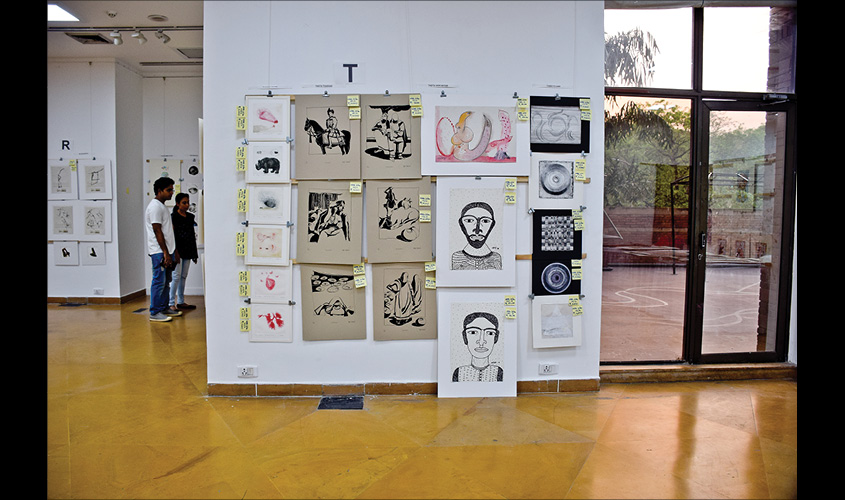Organised by Kolkata’s CIMA art gallery, the Affordable Art Mela is being hosted in Delhi for the first time ever, with a wide range of decently-priced drawings, watercolours and paintings by renowned artists on sale at the venue, writes Bhumika Popli.
It was a sight to behold. On Thursday evening, inside the Visual Arts Galley at Delhi’s India Habitat Centre, people were queuing up to buy art. The scene reminded one of a high-street fashion sale. Except that on sale here were paintings, all available at affordable prices. The Affordable Art Mela, on till 30 April, includes works by stalwarts and young artists, all priced within a range of Rs 3,000 to Rs 84,000.
This annual art event is organised by Kolkata’s CIMA (Centre of International Modern Art) gallery, and is being hosted for the first time in Delhi. Rakhi Sarkar, founder, CIMA, speaks to Guardian 20 on the Delhi debut
There are approximately 1,800 works on sale here, including drawings, paintings and mixed-media works, by more than 80 artists. At the venue, the artworks are displayed alphabetically. By 6 p.m. on Thursday, the walls where paintings by stalwarts like Prabhakar Kolte, Jogen Chowdhury and so on, were displayed were soon rendered bare. All the paintings sold out. Says Pushpa Kushwaha, an avid collector from Jaipur. “I bought a watercolour, an etching and a Madhubani painting. I came here just now and I was just walking around, looking at the works, thinking of what to buy and when I turned towards Lalu Prasad Shaw’s work, it was already gone.”

Sarkar says the sales are rapid because the works displayed here are among the finest in Indian contemporary art. She says, “Artists like Arpita Singh, Param Singh, Prabhakar Kolte among others have chosen these works through the entries we receive for CIMA’s art awards, which happen every two years. So we can guarantee the quality.”
For Sarkar, Delhi is an ideal testing ground for the art sale. She says, “This is a trial of sorts. We are trying to make it an annual event in Delhi . We can’t do too many cities in one go as the artworks are limited. Artists are giving these at considered rates, so they can’t be producing too much. Organising this kind of event is a huge fare and it takes commitment. As it was our first time here, we couldn’t keep sculptures as we do in Kolkata. Here we decided to stick to traditional media.”
Sarkar took inspiration for the Affordable Art Mela from the Nandan Mela, an annual art fair held at Santiniketan on the birth anniversary of the master artist Nandalal Bose. “At the Nandan Mela, participating artists painted for the residents of Santiniketan, and the students and professors who stayed there bought the artworks. For example, you could get a K.G. Subramanyan between Rs 20 to Rs 100. It was a very old tradition of Santiniketan but it got a little diluted in all kinds of problems. We took this idea from there because we wanted to create something very informal…something for the layperson…lovers of art.”
The artworks sold here come with a hologram, a stamp and a receipt of the purchase made for authenticity. Sarkar says, “We wanted an atmosphere where nothing is fake. One can also use a credit card to pay. We wanted to make everything very friendly. We don’t want a new collector to be intimidated by art. There is a certain intimidation in galleries, with their unnecessary jargons and complicated theory towards the artworks.

She adds, “It is not as such that every piece of art should be esoteric in nature that a layman doesn’t understand it. It is fine if an artwork is beautiful, sensitive and overall well-executed. Here at Art Mela, we are offering a casual, informal, friendly way of buying. You come, see, feel, you bring your friends along, you can have a little debate, choose, it is a totally new way of buying art. It is just like the Dilli Haat. The way you approach Dilli Haat, that’s the way you approach art here. Here a layman is closer to a painting. We are trying to keep it very simple, very approachable and very inclusive. No distinctions whatsoever.”
But Swati Gupta, a Delhi-based artist, is not too pleased with the way artworks are being showcased at the event. She says, “As an artist, I am actually just intrigued by this entire concept of the fair. Look at the way it is going on… There are some watercolour works here and people are just picking up paintings, casually flipping it over and keeping it. I am a water-colourist and seeing this I am actually worried. Watercolours are very delicate works. There is no one at some stalls to guide people. Even the works displayed on the wall don’t have a frame, not even an acrylic sheet to protect them. With oil-based works, it is fine but with paper works, which are mostly present here, a certain protection is needed. As an artist, I would be apprehensive if they had contacted me and asked me to sell my works here. Maybe that is one of the reasons they are ‘affordable’. The concept is nice but I really feel that the handling could have been better.”

